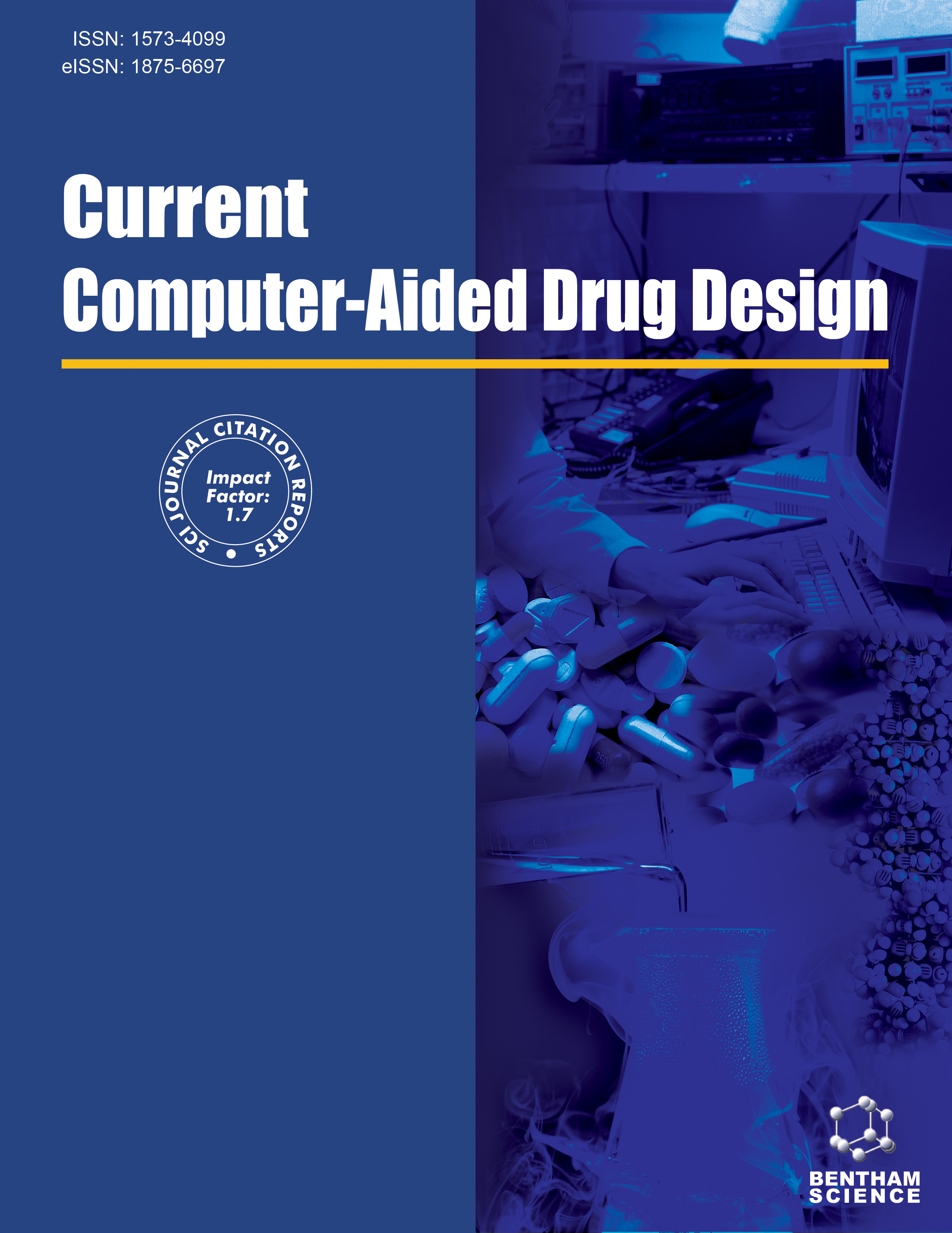- Home
- A-Z Publications
- Current Computer - Aided Drug Design
- Previous Issues
- Volume 20, Issue 6, 2024
Current Computer - Aided Drug Design - Volume 20, Issue 6, 2024
Volume 20, Issue 6, 2024
-
-
Rational Design of Dual Inhibitors for Alzheimer's Disease: Insights from Computational Screening of BACE1 and GSK-3β
More LessBackground: Alzheimer's disease (AD) is one of the most concerned neurodegenerative disorders across the world characterized by amyloid-beta (Aβ) plaques and neurofibrillary tangles (NFTs), leading to cognitive decline and memory loss. Targeting key pathways involved in AD like Aβ and NFT pathways, are crucial for the development of effective therapeutic strategies. In this study, we aimed to identify and establish promising dual inhibitors targeting BACE1 and GSK-3β, two proteins implicated in Aβ and NFT formation respectively. Methods: We have used molecular docking, ADME property analysis, and MMGBSA calculations for the identification of hit molecules and further evaluation of binding affinity, drug-like properties, and stability against BACE1 and GSK-3β. Results: Our results demonstrated strong binding affinities of ZINC000034853956 towards the active sites of both proteins, with favorable interactions involving key residues crucial for inhibitory activity. Additionally, ZINC000034853956 exhibited favorable drug-like properties. MD simulations revealed the stable binding of ZINC000034853956 to both BACE1 and GSK-3β over a 50 ns period, with consistent ligand-protein interactions, such as hydrogen bonding and hydrophobic contacts. These findings highlight the potential of ZINC000034853956 as a promising candidate for AD treatment, acting as a dual inhibitor targeting both BACE1 and GSK-3β. Overall, our study provides valuable insights into the potential of ZINC000034853956 as a dual inhibitor for AD. The strong binding affinity, favorable drug-like properties, and stability observed in MD simulations support its suitability for further optimization and preclinical studies. Conclusion: Further investigations are warranted to elucidate the precise molecular mechanisms and therapeutic benefits of ZINC000034853956. Our findings offer hope for the development of novel therapeutic interventions targeting crucial pathways involved in AD neurodegeneration.
-
-
-
Graph-DTI: A New Model for Drug-target Interaction Prediction Based on Heterogenous Network Graph Embedding
More LessAuthors: Xiaohan Qu, Guoxia Du, Jing Hu and Yongming CaiBackground: In this study, we aimed to develop a new end-to-end learning model called Graph-Drug-Target Interaction (DTI), which integrates various types of information in the heterogeneous network data, and to explore automatic learning of the topology-maintaining representations of drugs and targets, thereby effectively contributing to the prediction of DTI. Precise predictions of DTI can guide drug discovery and development. Most machine learning algorithms integrate multiple data sources and combine them with common embedding methods. However, the relationship between the drugs and target proteins is not well reported. Although some existing studies have used heterogeneous network graphs for DTI prediction, there are many limitations in the neighborhood information between the nodes in the heterogeneous network graphs. We studied the drug-drug interaction (DDI) and DTI from DrugBank Version 3.0, protein–protein interaction (PPI) from the human protein reference database Release 9, drug structure similarity from Morgan fingerprints of radius 2 and calculated by RDKit, and protein sequence similarity from Smith-Waterman score. Methods: Our study consists of three major components. First, various drugs and target proteins were integrated, and a heterogeneous network was established based on a series of data sets. Second, the graph neural networks-inspired graph auto-encoding method was used to extract high-order structural information from the heterogeneous networks, thereby revealing the description of nodes (drugs and proteins) and their topological neighbors. Finally, potential DTI prediction was made, and the obtained samples were sent to the classifier for secondary classification. Results: The performance of Graph-DTI and all baseline methods was evaluated using the sums of the area under the precision-recall curve (AUPR) and the area under the receiver operating characteristic curve (AUC). The results indicated that Graph-DTI outperformed the baseline methods in both performance results. Conclusion: Compared with other baseline DTI prediction methods, the results showed that Graph-DTI had better prediction performance. Additionally, in this study, we effectively classified drugs corresponding to different targets and vice versa. The above findings showed that Graph-DTI provided a powerful tool for drug research, development, and repositioning. Graph- DTI can serve as a drug development and repositioning tool more effectively than previous studies that did not use heterogeneous network graph embedding.
-
Volumes & issues
-
Volume 21 (2025)
-
Volume 20 (2024)
-
Volume 19 (2023)
-
Volume 18 (2022)
-
Volume 17 (2021)
-
Volume 16 (2020)
-
Volume 15 (2019)
-
Volume 14 (2018)
-
Volume 13 (2017)
-
Volume 12 (2016)
-
Volume 11 (2015)
-
Volume 10 (2014)
-
Volume 9 (2013)
-
Volume 8 (2012)
-
Volume 7 (2011)
-
Volume 6 (2010)
-
Volume 5 (2009)
-
Volume 4 (2008)
-
Volume 3 (2007)
-
Volume 2 (2006)
-
Volume 1 (2005)
Most Read This Month


